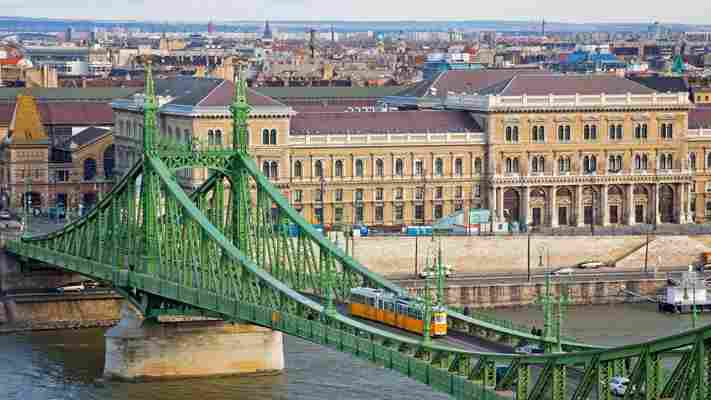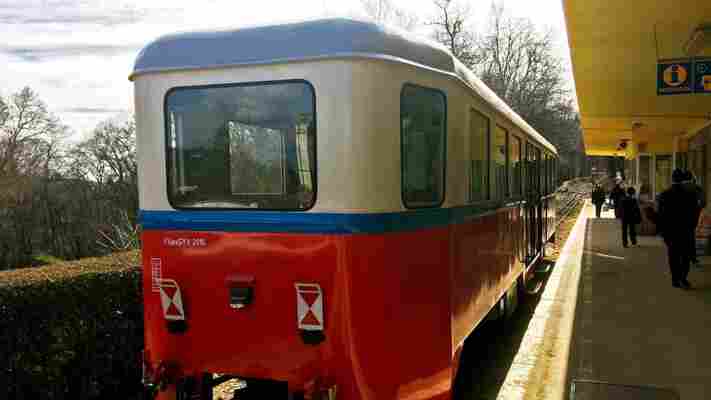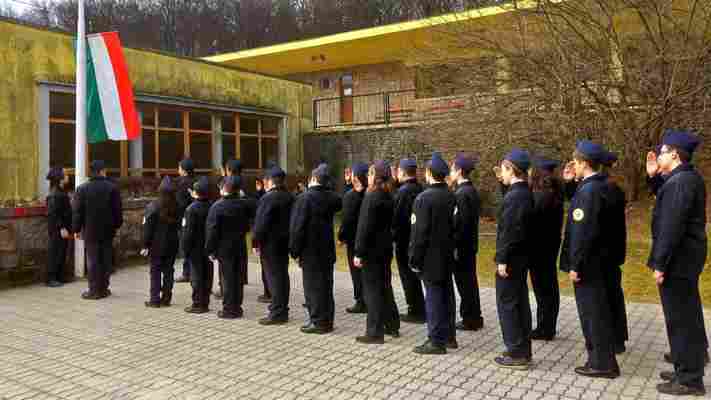Article continues below
With its shelves lined with worn textbooks and corridors plastered with drawings, noisy Gyermekvasútas Otthon on the western outskirts of Budapest seems like any normal school before the bell rings. Peer through the windows and you may see muss-haired children sitting on desks, teasing friends, toying with mobile phones or doodling in jotters as they wait for the day to begin.

Budapest’s historic trams are a popular way to get around the city (Credit: Oleksandr Prykhodko/Alamy)
But look closer and you’ll notice something odd. Those textbook subjects aren’t algebra or English. Instead they bear the stamp of MÁV START Zrt , the Hungarian State Railways. By the whiteboard, past the teacher’s desk, a cartoon poster reveals the detailed safety procedure for what to do when a deer ‒ or more commonly a hedgehog ‒ strays onto the tracks and into harm’s way. Next to it is a blueprint for the inner workings of the ultimate big toy: a locomotive engine.
Located in the suburbs at the end of the Hűvösvölgy tram line – one of 10 metro and suburban lines in Budapest ‒ Gyermekvasútas Otthon isn’t a learned place of academia. It’s an extracurricular training ground for the 11.7km Gyermekvasút , or Train Line 7. Travelling at 20kmh over the contours of the Buda Hills to Széchenyi Hill on the forested outskirts of the city, this tram line is one of the longest and fastest of its kind in the world. And it’s entirely run by children.
“People think it’s odd that 10- to 16-year-olds are the stationmasters, but that’s not all they do,” said Balázs Sáringer, one of the academy’s 20-year-old supervisors. “They operate the railroad switches, they make the passenger announcements, they control the signals, they sell the tickets. The only thing they don’t do is drive the train.”

Railways run by children were common during the Soviet era (Credit: Mike MacEacheran)
Such daunting work may come as a surprise to most adults, but railways run by children used to be a common fixture on the map during Soviet times. The phenomenon originated in the former USSR, with the world’s first children’s railway opened in Moscow’s Gorky Park in 1932. The possibility it would be a one-off was not the Communist Party line, so before the breakup of the USSR, and over the next six decades, a rich concentration of 52 such railroads were built across Eastern Europe by the Pioneers, the youth section of the party.
Their charm, historians say, lies in the pistons, not the polish.
Far from simplistic, figure-of-eight funfair rides, many of the tracks carried full-size narrow-gauge rolling stock with skeleton crews. Some, like the Far East Children’s Railway in the remote Russian town of Khabarovsk or the Small South Western Railway in Kiev, still function, exhibiting characteristics of steam engine technology rarely seen on modern-day railways. Their charm, historians say, lies in the pistons, not the polish.
The point of it all, at least back then, was to instil a sense of comradery and discipline in teenagers, as well as to single out future Communist Party leaders. Most of these train lines have been railroaded to closure since, but the Hungarian State Railways is keen to preserve their heritage. MÁV START Zrt believes it remains of intrinsic value to the children’s education, while a welcome by-product is the birth of a new generation of workers. And on such merits, Budapest’s Children’s Railway can be taken as a study in the worth of holding on to yesterday.
No visitor normally makes it to the training centre at Gyermekvasút before breakfast, but to do so is to see something extraordinary and reminiscent of another time. On the day of my visit, at 8am sharp, the children were ceremonially frog-marched from their classroom into a concrete courtyard for roll call. Those on duty, dressed in navy jackets and peaked military caps, listened with respect as the real business of the day began.

The day starts at 8am with roll call in the courtyard (Credit: Mike MacEacheran)
Following the drill, uniforms were inspected, baggy shirts were tucked in and scuffed shoes were discreetly polished on the back of flannel trouser legs. Serious yet informal, heads bowed yet mouths open, the young workers marched to the base of the station flagpole at Hűvösvölgy, singing songs while the horizontal tricolour of the Hungarian flag unfurled in the sun. Like fingers searching for a lost memory, the lyrics reached back to 1947 when the children’s train was originally conceived.
All the while during the ceremony, Sáringer handed out work schedules to his 25-strong group. Around him were a demographic cross-section of 10- to 14-year-olds who had been selected from schools across the Hungarian capital. They were here not just for having good grades, but also for having passed an intensive six-month training programme. Only now, after having applied months beforehand to join the programme, were they ready to ride the rails.
The tin-crackle voice from a scratchy Tannoy loudspeaker cut through the singalong, and I joined the group boarding the pre-service staff train as it readied to depart. I sat next to 14-year-old Mihály Cserjegi, an old-timer on the railway with three years of service completed. As the train left, curving west from Budapest’s sprawl to a place where the streets thinned out and forests took over, Cserjegi told me why it made so much sense to him.
Children undergo an intensive six-month training programme to join the tram crew (Credit: Mike MacEacheran)
“My father worked here when he was younger and I wanted to follow in his footsteps,” he said, the rumble of the 32-tonne train breaking the still of the enveloping forest. “I haven’t done this to get out of school. It’s exactly the opposite.”
Next to Cserjegi, 11-year-old Jazmin Hayek, a pint-sized ticket seller with a clipped English accent, was equally quick to extoll the virtues of train life. “Before I came to work here my maths wasn’t so good,” she said. “But now it’s much better. It’s helped all of my grades.”
This is more than tradition. It’s about education.
While Hungarians are for the most part proud of their history, less credible to others is that the train propagates a strict Communist-era work ethic. Camaraderie and teamwork are in the warp and weft of the railway’s fabric, as they were to Soviet-era Moscow, but is that such a bad thing? Like most other veterans of the rail service, Sáringer shakes his head at this.
“Lots of people hate the idea of the train because of its heritage,” he shrugged, the window reflecting the turn-of-the-century rail terminus. “But this is more than tradition. It’s about education. Selling tickets is a lesson in maths. Working switches is a lesson in physics. Welcoming foreign visitors can be an English class. Ask the children who work here; they understand the value of it.”
The programme teaches students real life skills in math, physics and English (Credit: Mike MacEacheran)
When the train readied to leave on the day’s first scheduled 50-minute journey, it was easy to see what he meant. Teenage inspectors sold and stamped tickets while joking with customers. On board, uniformed children chattered with passengers in their seats, the frisson of excitement palpable, while the bustling station hummed with anticipation. On the platform, a 10-year-old station master checked his watch to make sure everything was on time.
A whistle was blown, the signal light turned from lollipop red to green, carriage doors were bolted and the train bellowed, alerting the 11-year-old signalman further up the line.
Then the train departed and the platform returned to deep silence once more.
Join over three million BBC Travel fans by liking us on Facebook , or follow us on Twitter and Instagram .
If you liked this story, sign up for the weekly bbc.com features newsletter called "If You Only Read 6 Things This Week". A handpicked selection of stories from BBC Future, Earth, Culture, Capital and Travel, delivered to your inbox every Friday.
